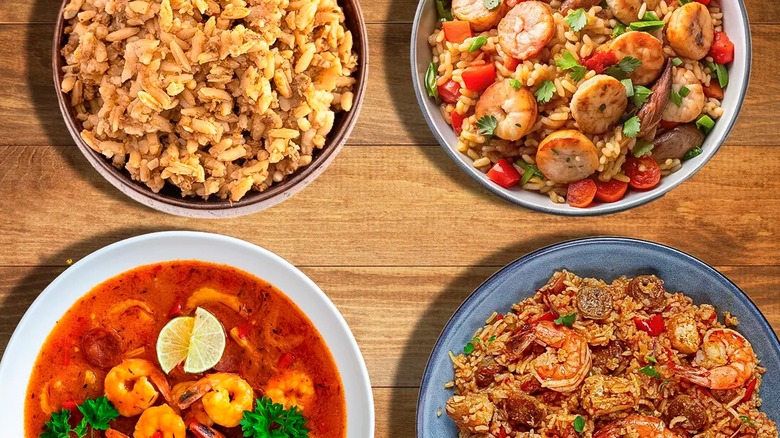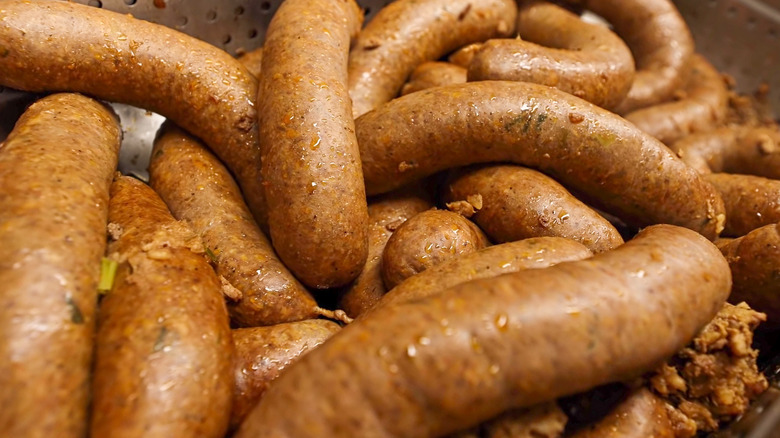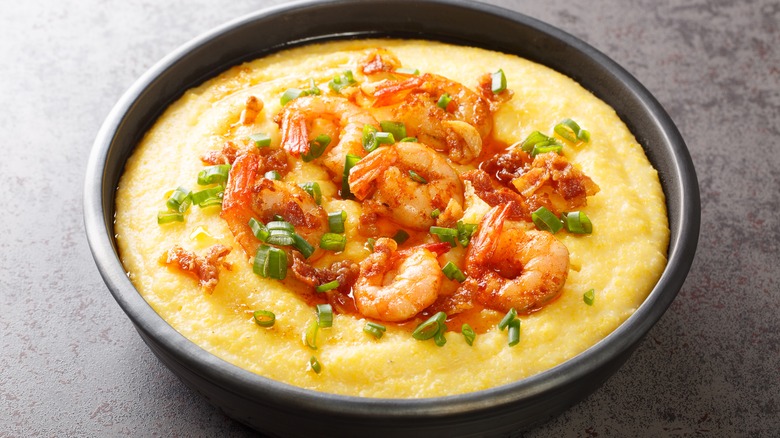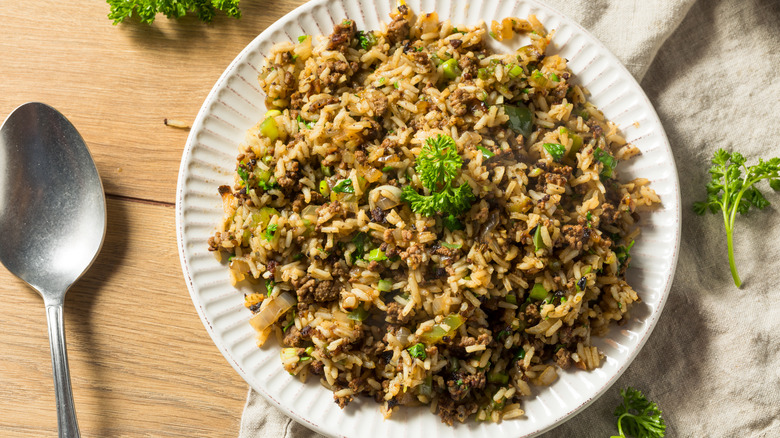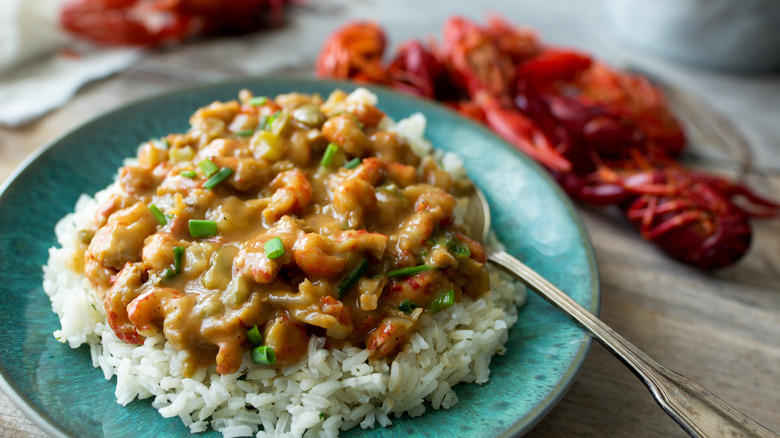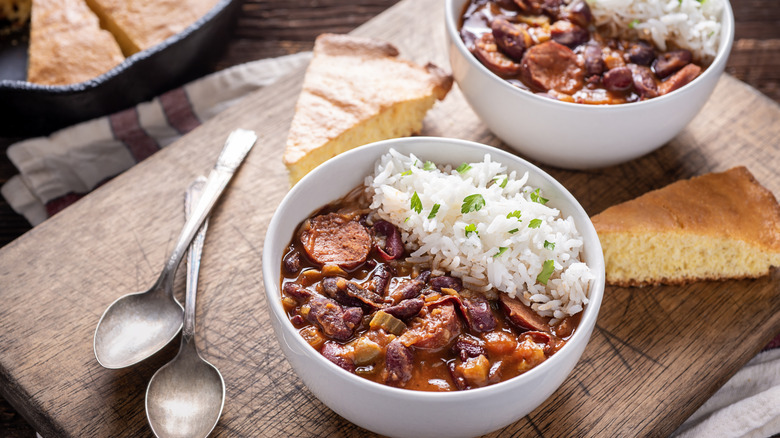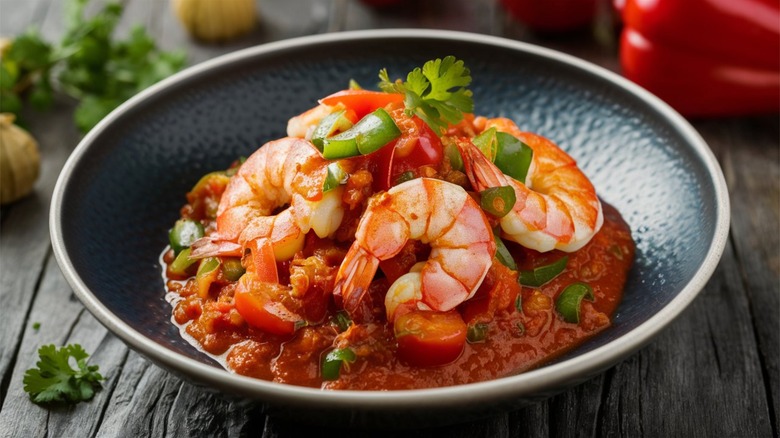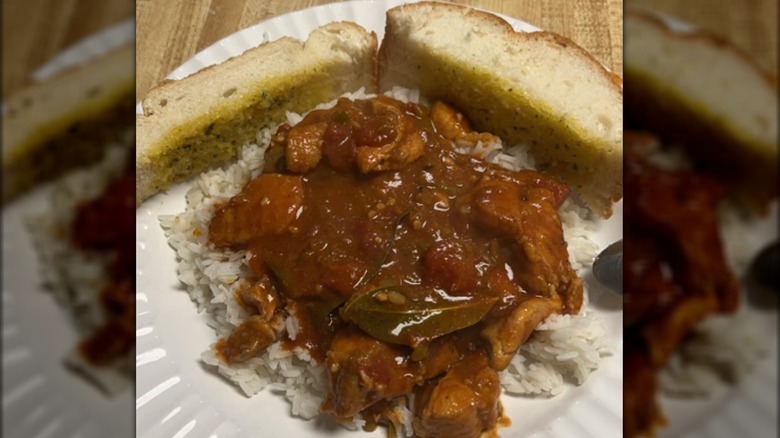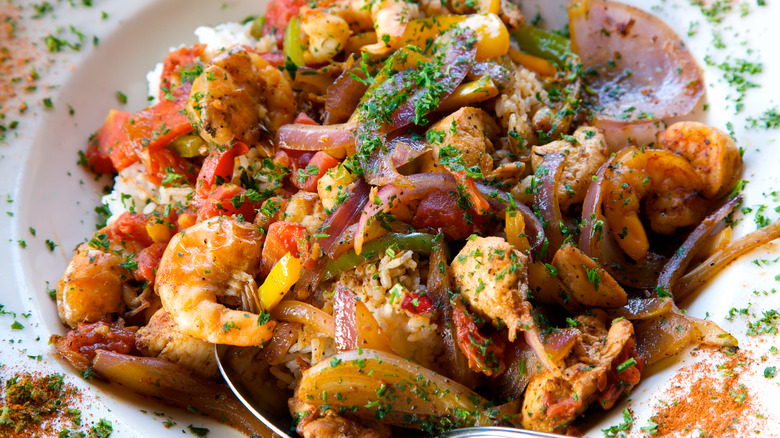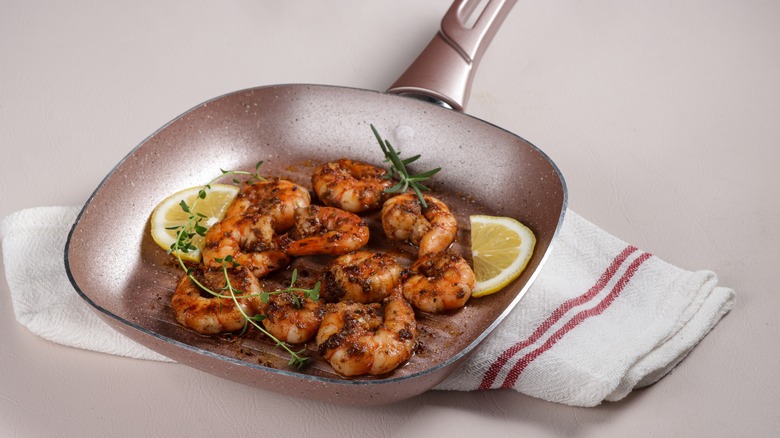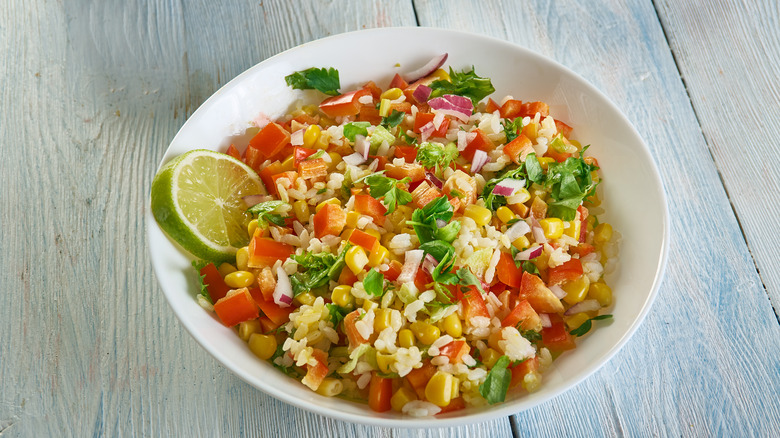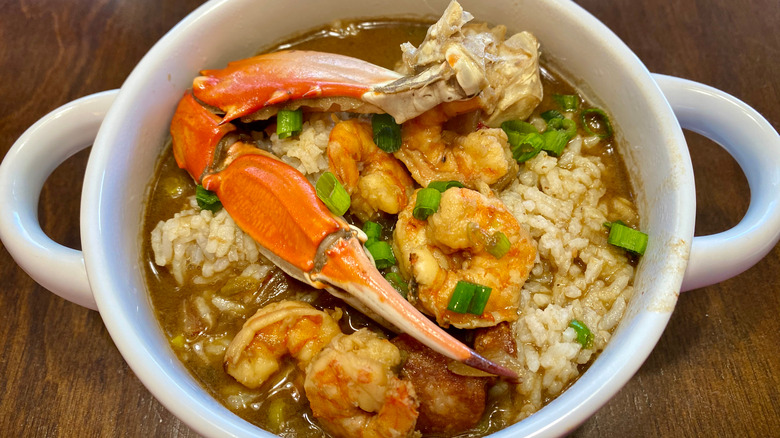12 Cajun And Creole Dishes You Need To Try At Least Once
There's no better American cuisine to show off the country's melting pot status than Louisiana's. The Cajun people, originally from Eastern Canada and known as Acadians, immigrated to the Southeastern United States in the 1700s. Modern-day Creole people are descendants of colonial French, African American, and Native American ancestors. These two prominent cultures have established a rich culinary heritage across Louisiana, with food that incorporates elements of French Canadian, Native American, Caribbean, African, and Spanish cooking styles and ingredients. It's some of the most distinct cuisine in the world.
Cajun and Creole cuisines are defined by their use of the abundant seafood teeming from the fertile wetlands of Louisiana and Gulf of Mexico. Although the terms are sometimes used interchangeably, there are stark differences between these two prominent epicurean arts. The differences in Cajun and Creole cuisine lie mostly in their appearance in the rural South versus the cities, respectively. Essential Cajun ingredients incorporate specific loud and spicy seasonings, as opposed to Creole cuisine's mellow, herbaceous flare.
I've teamed up with food blogger Nicole Caridad Ralston of Off the Eaten Path NOLA and Chef Eryn A'leah, a New Orleans private chef, to showcase the most legendary dishes of both cuisines. These two food experts chose their favorite time-honored Louisiana dishes to act as examples of the best in the worlds of Cajun and Creole cooking, so you can get acquainted with the cuisine no matter where in the world you are.
Boudin
A lesser-known Cajun delight, boudin is a unique, sausage-like snack specific to Louisiana. "Boudin is a traditionally Cajun dish, although you can find similarities in Spanish and Caribbean cultures," says Nicole Caridad Ralston. "[It] consists of seasoned rice and pork, cooked together and stuffed inside a sausage casing. It can be eaten fried or pan-seared. (...) Lafayette, Louisiana is home to the Boudin Trail, where you can try all types of boudin, including crawfish, smoked, shrimp, and even cauliflower." Besides pork, boudin sometimes features duck, venison, and liver, along with expertly curated Cajun seasonings and fresh, local veggies.
Boudin is a must-try Southern delicacy that comes in many styles and forms. Boudin balls are a popular appetizer choice in New Orleans and rural Louisiana. These crispy, bite-sized morsels consist of fried boudin surrounded by crispy breading. They typically come accompanied by homemade remoulade sauce for dipping — made in the traditional Cajun style, of course. Boudin and boudin balls are found all over Louisiana, from gas stations to Michelin-rated restaurants and everywhere in between.
Catfish, or shrimp, and grits
Both catfish and shrimp are cornerstones in Southern cooking, and when combined with grits — well, it doesn't really get more Southern than that, y'all. This Lowcountry dish is intrinsic to the Southern U.S. as a whole, but Louisiana chefs put a Cajun spin on it to rival versions found in restaurants from the Carolinas to Florida. Fish and grits are a quintessential rustic meal that can be eaten any time of day, but most of the time, this dish is enjoyed for breakfast. Chef Eryn A'leah says that her clients enjoy this meal the most, and she believes it's essential for a proper Southern breakfast.
For those of us up North with questions: Grits are a type of porridge made from ground dent corn — a starchier, softer type of corn kernel. The corn is ground and then boiled until soft, and usually accompanied by butter and milk. This versatile ingredient is used in a variety of Southern meals, with shrimp and grits and catfish and grits being the most prevalent on restaurant menus and in kitchens throughout the South. A proper Cajun fish and grits meal includes bacon (or tasso), celery, bell pepper, hot sauce, cheese, and the always-necessary Cajun seasoning blend.
Dirty rice
Although its name might not sound the most appealing, dirty rice is beloved by folks all over the Southeastern U.S. I happen to love this recipe mostly because it's not something you'll frequently find on restaurant menus in New Orleans, but you'll most definitely find it in nearly every residential abode in the city and beyond. Cajun dirty rice is a down-home staple and a nostalgic comfort food for those who were born and raised in the South. "I think this should be on every party menu, next to jambalaya," says chef Eryn A'leah. "They're like cousins-in-law for me." This dish combines multiple elements of Louisiana cuisine, including rice — a staple of Cajun and Creole cooking — as the star of the show.
A typical dirty rice recipe is as simple as combining a few classic ingredients and allowing them to work their magic together. Beef, pork, celery, peppers, onion, and spicy seasonings are added to rice to create this side dish. Dirty rice is versatile enough to add anything you may have lying around the kitchen — corn, okra, bacon, beans — you name it. Add extra meat if this dirty rice will be the meal's main event, and you'll have a hearty and filling dinner made from timeless, traditional ingredients.
Crawfish or shrimp étouffée
Étouffée is probably the most elusive of all Cajun and Creole dishes, with most of us having heard of it, but only those from Louisiana knowing what separates it from other local delicacies. The word étouffée comes from the French word meaning "to smother" — and anyone who's ever stepped foot inside a Waffle House knows that, when it comes to food, the word "smother" is music to the ears. The first record of étouffée comes from Breaux Bridge, Louisiana, otherwise known as the crawfish capital of the world. Étouffée can be found in both Cajun and Creole styles, with minor differences between the two that might seem trivial to outsiders but make a world of difference to local Louisianans. Creole étouffée requires a French-style roux and has notes of herbs and subtle heat, while its Cajun version utilizes butter, lard, and bolder, spicier seasonings.
The difference between gumbo and étouffée is that the latter typically only features either crawfish or shrimp, with a delicate combination of savory veggies in a thick sauce. Like gumbo, étouffée starts with a roux in the Creole tradition as its base, but instead of transforming that roux into a stew loaded with multiple meats and different varieties of seafood, étouffée is more reminiscent of a sauce. Rice is then doused — or smothered, rather — with the thick seafood-based sauce to create a satisfying meal with deep roots in the region's culinary history.
Red beans and rice
If it's Monday in New Orleans, that means it's red beans and rice for dinner. This simple, thrifty dish was introduced to the Southeastern U.S. by Haitian immigrants in the 1700s. Leftover ham from traditional Sunday dinners is used with other budget-friendly ingredients to create a meal that's healthy, fast, delicious, and — most importantly — full of spicy flavor. Today, the dish usually has elements of its Caribbean roots, but with modern Cajun flare that can only be found in Louisiana. You'll find that households throughout the city have a pot of red beans and rice simmering on the stove on busy Mondays while local restaurants are serving their special take on the classic dish for cheap.
New Orleans red beans and rice consists of long-grain rice, beans, Cajun or Creole seasoning, peppers, onions, garlic, and meat. Chef Eryn A'leah prefers the tradition of pickled meat in her version of the dish. Red beans and rice can easily be made vegan by omitting the meat or substituting a plant-based version instead.
Although I'm located in the Northeast, I still adhere to the Monday tradition to harken back to my days spent in NOLA. I always pulse my beans with an immersion blender or in a food processor so that only some are smooth and some chunks remain — this adds extra creaminess and a delicious texture to the dish.
Shrimp Creole
If you're looking for a Louisiana dish where seasonings shine and shrimp is the star of the show, look no further than shrimp Creole. Like many dishes on this list, shrimp — an imperative ingredient in both Cajun and Creole cuisine — is at the center of the meal, while a host of spicy seasonings bring out the shrimp's natural essence and add complex flavor. Like many Creole dishes in Louisiana, this dish is often found on sophisticated restaurant menus, keeping its roots in the city as opposed to the more rural areas of the state. But different renditions can be found no matter where you go in the South, from East Texas to Mississippi. "This spicy tomato-based dish is super easy to make and even easier to enjoy in most (...) restaurants in Louisiana," says Nicole Caridad Ralston.
Spicy shrimp Creole is a simple combination of shrimp, vegetables, and spices, all made into a one-pot meal. Simply cook up a Cajun-style mirepoix — which swaps out carrots for bell peppers and is known as "the holy trinity" — and then add stock, tomatoes, and Creole seasoning. Cajun seasoning can be used in its stead, but Creole seasoning is earthier than Cajun seasoning, giving the dish its signature flavor. Add a little extra cayenne for added spice, and watch the fishy and tomatoey flavors of the bayou come to life.
Catfish courtbouillon
If you're on the hunt for a real down-home, country meal, catfish courtbouillon absolutely must be on the menu. This dish is similar to gumbo, but typically, it's made with very simple ingredients, yet elevated, Creole-inspired interpretations of the dish can be found on restaurant menus in New Orleans. My favorite versions of catfish courtbouillon are ones served by friends and family, made the old-fashioned way over the coals of a large bonfire. The stew is made with local veggies and handmade stock using crawfish and shrimp shells left over from last night's dinner. If you ever find yourself in Lafayette — genuine Cajun country — seek out a bowl of catfish courtbouillon for a true taste of the flavors of the South.
A traditional recipe includes the holy trinity — naturally — and catfish, tomatoes, Cajun seasonings, roux, stock, and just a little parsley for garnish. I love that this dish encompasses everything about the rural South — from catfish fresh from the bayou to simple, one-pot cooking techniques and ingredients that hint at its French inspiration. There's not a soul in the South that didn't grow up eating some form of catfish stew, making this dish one of the most universally treasured and nostalgia-inducing in the region.
Jambalaya
Jambalaya is one of those dishes that everyone thinks of when Southern food comes to mind. This hearty, festive dish is a quintessential example of Louisiana's diverse heritage. It combines Spanish, French, Native American, African, and Caribbean ingredients and cooking techniques. Jambalaya is very similar to paella, acting as a slightly spicier, more rustic version of the esteemed Spanish dish. While elegant saffron is the seasoning of choice in paella, jambalaya gets its vibrant flavor from cayenne pepper and other Cajun-inspired herbs and spices. There are two distinct versions of jambalaya: one hailing from the city and one with roots in the rural country. The difference between Creole and Cajun jambalaya is that Creole jambalaya incorporates tomatoes, while Cajun jambalaya does not — I bet you're sensing a pattern here.
Jambalaya combines nearly every staple of the Gulf Coast region into one lively medley of meat, seafood, rice, and spices. Chef Eryn A'leah notes that — like many Cajun and Creole dishes — this favorite dish of hers is an easy, one-pot meal. A traditional recipe for jambalaya typically involves a combination of pork — in the form of Southern andouille sausage — chicken, shrimp (or crawfish), veggies, rice, and loads of seasonings that aren't for the faint of heart. Jambalaya is a perfect one-pot dinner, but for a genuine Louisiana experience, order or make yours with a side of Southern cornbread and collard greens.
Beignets
There are plenty of famous desserts hailing from Louisiana — from bread pudding to bananas foster to king cake — but none are as treasured as beignets. Beignets are originally a French delicacy, but the people of New Orleans recreated the esteemed recipe with their own unique spin. Unlike the French version of the pastries, New Orleans beignets are made with fried, leavened dough with an airy center and dusted with powdered sugar. French beignets, however, are crafted from pâte à choux and sometimes filled with various fruity jams.
Of all the places to acquire the best beignets in New Orleans, Café Du Monde is certainly the most famous. The beignets at Café Du Monde are legendary all over the world, and tourists line up for hours to receive a taste of the acclaimed, yet humble, pastry. Unlike most popular desserts in the U.S., beignets have just a subtle sweetness and are sometimes even eaten at breakfast time in the city in lieu of a classic donut or bagel. A cup of uniquely flavored chicory coffee is the perfect pairing for these fluffy morsels, and, luckily, Café Du Monde does both of these favorite New Orleans treats right.
Barbecue shrimp
Nearly every restaurant from New Orleans to Lafayette has barbecue shrimp on its menu. The dish was first invented in 1953 in the legendary New Orleans Creole restaurant Pascal's Manale, which still serves the original rendition of the dish to this day. Now, I know what you're thinking — how is shrimp smothered in barbecue sauce a Creole creation? Despite its name, this dish has nothing to do with the sauce that you'd slather on a steak or chicken wing. "[I] love this dish for an appetizer," says chef Eryn A'leah. "It's a crowd favorite, but it can get messy. It's worth the mess." As well as a go-to appetizer, barbecue shrimp is a popular protein option for a spicy po'boy — a New Orleans' interpretation of a long deli sandwich.
Instead of genuine barbecue sauce, barbecue shrimp in Louisiana consists of shrimp cooked in large quantities of butter that's been seasoned with Worcestershire sauce, garlic, and herbaceous and spicy Creole seasonings. The dish is simple and light, making it an ideal start to any Creole dining experience. Usually, barbecue shrimp is served with some crusty French bread, so you can soak up all that leftover seasoned butter.
Corn maque choux
This lesser-known Cajun delight is a veggie-packed side dish that makes an ideal accompaniment for a meat-centric meal. A healthy blend of veggies from the South comes together with Creole seasonings for a sweet-heat dish that highlights the region's culinary heritage and pays homage to the Native cultures that established the foundations for this beloved, modern cuisine. Recipes vary, with slight differences in familial recipes passed down over the course of generations, but at its heart, maque choux is a celebration of the bounty of one of the cornerstones of American cuisine across the nation: corn.
Corn maque choux is made up of corn, the holy trinity, bacon, Creole seasonings, and spicy peppers, like jalapeños. The mix is then thinned with either chicken stock, milk, or a combination of the two, but still retains a chunky, thick texture. This simple veggie concoction allows the seasonings to be the star of the show in this dish, so if you're taking a crack at corn maque choux, be sure to make a seasoning mix from scratch. Bring this dish as a side to serve at a crawfish boil, or dress it up to be a main course. "[Corn maque choux] is a perfect side dish or can be the main event if you add some shrimp," says Nicole Caridad Ralston.
Gumbo
And finally, we end with the most iconic Louisiana dish of all time — gumbo. Gumbo is a versatile dish that always starts with a roux — a dark one, at that. This dark roux adds a rich, nutty flavor, and separates gumbo from a garden-variety seafood stew. The term gumbo is thought to be derived from the West African word for okra, another differentiating factor in this eclectic, traditional meal.
Cajun and Creole gumbo both have their own unique attributes, and a longstanding, heated debate exists among Louisiana locals over which is better. As you can probably guess, Creole gumbo features floral, delicate Creole herbs, spices, and tomatoes, while Cajun gumbo involves spicier, bolder seasonings and no tomatoes. Both versions of the dish can include a plethora of meat and seafood options; usually a combination of at least two. These meats and seafoods are usually locally sourced, in true Cajun and Creole fashion.
Seafood like shrimp, crawfish, catfish, oysters, whitefish, and crab can all be found in gumbo, and if you're lucky enough to find a seafood gumbo that features all of those fruits of the sea, I suggest you take advantage. Non-seafood ingredients in gumbo are usually limited to chicken and andouille sausage. Take a food tour in New Orleans to discover the best restaurants for gumbo that the city has to offer, although New Orleans locals will tell you that the best gumbo is found at their house (and they'll probably invite you over for some, too).
